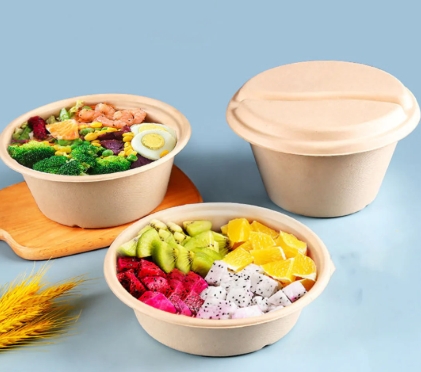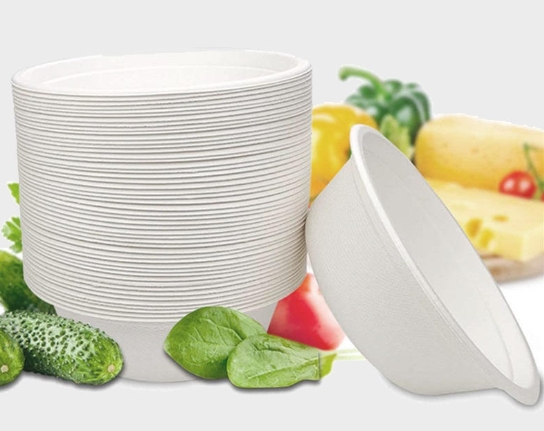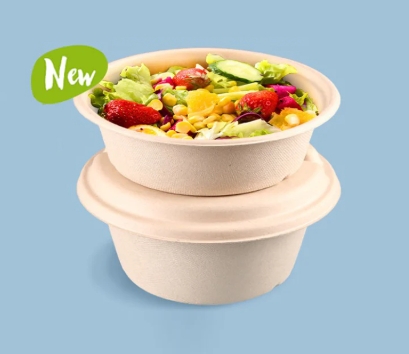
Content Menu
● The Problem with Traditional Plastic Food Packaging
>> The Prevalence of Single-Use Plastics
>> Environmental Impact
● What Are Bowl And Lid Sets?
>> Definition and Types
>> Key Features
● How Bowl And Lid Sets Reduce Plastic Waste
>> Promoting Reuse Over Disposal
>> Supporting Bulk and Takeaway Models
>> Facilitating Recycling and Composting
>> Reducing Contamination in Recycling Streams
● Materials Used in Sustainable Bowl And Lid Sets
>> Glass
>> Stainless Steel
>> Bamboo
>> Food-Safe Plastics
● Benefits for Businesses and Consumers
>> Cost Savings
>> Enhanced Brand Image
>> Improved Food Safety and Quality
>> Convenience and Versatility
● Overcoming Challenges in Adoption
>> Changing Consumer Habits
>> Infrastructure and Logistics
>> Regulatory Support
● Real-World Impact: Case Studies
>> Restaurants and Cafés
>> Grocery Stores
>> Corporate and Institutional Settings
● The Future of Food Packaging
>> Innovation in Materials
>> Circular Economy Models
>> Consumer Awareness and Engagement
● How to Transition to Bowl And Lid Sets
>> For Consumers
>> For Businesses
● Conclusion
● FAQ
>> 1. What materials are most commonly used for sustainable bowl and lid sets?
>> 2. How do bowl and lid sets help reduce plastic waste?
>> 3. Are bowl and lid sets suitable for all types of food?
>> 4. What are the challenges in switching to bowl and lid sets?
>> 5. Can bowl and lid sets be recycled or composted at the end of their life?
Plastic waste is one of the most urgent environmental issues facing the world today. The food packaging industry is a major contributor to this problem, as single-use plastics dominate the market due to their convenience and low cost. However, the growing awareness of environmental sustainability is driving a shift toward more eco-friendly alternatives. Among these, bowl and lid sets stand out as a practical and effective solution for reducing plastic waste in food packaging. This article delves into how bowl and lid sets are changing the industry, their environmental benefits, and why they are essential for a sustainable future.

The Problem with Traditional Plastic Food Packaging
The Prevalence of Single-Use Plastics
Single-use plastics such as clamshell containers, wrappers, and disposable trays are widely used in food packaging. These items are typically discarded after one use, contributing to the growing issue of plastic pollution. Most of these plastics are not recycled and end up in landfills, rivers, or oceans, where they persist for centuries and harm wildlife.
Environmental Impact
Food packaging waste is particularly problematic because it is often contaminated with food residues, making recycling difficult or impossible. As a result, most plastic food packaging is either incinerated, which releases harmful emissions, or left to degrade slowly in the environment. The accumulation of plastic waste poses significant risks to ecosystems, human health, and the planet as a whole.
What Are Bowl And Lid Sets?
Definition and Types
Bowl and lid sets are reusable or recyclable containers designed for storing, transporting, and serving food. Unlike single-use packaging, these sets are made from durable materials such as glass, stainless steel, bamboo, or high-quality, food-safe plastics. They come in various sizes and shapes to accommodate different types of food, from salads and soups to entrees and desserts.
Key Features
- Reusable: Designed for multiple uses, reducing the need for disposable packaging.
- Durable: Built to withstand repeated washing and handling.
- Versatile: Suitable for both hot and cold foods, and often microwave and dishwasher safe.
- Secure: Lids provide a tight seal, preventing leaks and spills.
How Bowl And Lid Sets Reduce Plastic Waste
Promoting Reuse Over Disposal
One of the most significant ways bowl and lid sets help reduce plastic waste is by encouraging a culture of reuse. Instead of discarding packaging after a single use, consumers and businesses can wash and reuse these containers many times. This simple change dramatically decreases the volume of plastic waste generated by the food industry.
Supporting Bulk and Takeaway Models
Bowl and lid sets are ideal for bulk food purchases and takeout orders. Many grocery stores and restaurants now offer incentives for customers who bring their own containers, further reducing reliance on single-use plastics. By adopting bowl and lid sets, businesses can lower their packaging costs and environmental impact.
Facilitating Recycling and Composting
When made from recyclable or compostable materials, bowl and lid sets can be responsibly disposed of at the end of their life cycle. Some sets are designed to be compostable, breaking down into harmless substances rather than lingering as pollutants. Even those made from recyclable plastics are easier to process than contaminated single-use packaging.
Reducing Contamination in Recycling Streams
Reusable bowl and lid sets are less likely to be contaminated with food waste compared to flimsy single-use containers. This increases the likelihood that the materials will be effectively recycled, further reducing the burden on landfills and incinerators.
Materials Used in Sustainable Bowl And Lid Sets
Glass
Glass bowl and lid sets are popular for their durability, non-toxicity, and recyclability. They do not leach chemicals into food and can be recycled indefinitely without loss of quality.
Stainless Steel
Stainless steel is another excellent material for sustainable food containers. It is lightweight, resistant to corrosion, and can be used for both hot and cold foods. Stainless steel containers are also fully recyclable at the end of their lifespan.
Bamboo
Bamboo is a rapidly renewable resource that is increasingly used in eco-friendly food packaging. Bamboo bowl and lid sets are biodegradable and compostable, making them an attractive option for those seeking plastic-free alternatives.
Food-Safe Plastics
Some bowl and lid sets are made from high-quality, BPA-free plastics that are designed for repeated use. While not as sustainable as glass or stainless steel, these plastics still offer significant benefits over single-use packaging by reducing overall waste.
Benefits for Businesses and Consumers
Cost Savings
Although the initial investment in reusable bowl and lid sets may be higher than purchasing disposable packaging, the long-term savings are substantial. Businesses can reduce their ongoing packaging costs, while consumers save money by reusing containers instead of buying new ones.
Enhanced Brand Image
Companies that adopt sustainable packaging solutions such as bowl and lid sets can enhance their brand image and appeal to environmentally conscious consumers. This can lead to increased customer loyalty and a competitive edge in the market.
Improved Food Safety and Quality
Bowl and lid sets often provide better protection for food, keeping it fresh and safe from contaminants. The secure lids prevent leaks and spills, making them ideal for transport and storage.
Convenience and Versatility
Reusable containers are convenient for meal prep, storage, and on-the-go eating. They can be used at home, at work, or while traveling, making them a versatile addition to any kitchen.

Overcoming Challenges in Adoption
Changing Consumer Habits
One of the main barriers to widespread adoption of bowl and lid sets is changing consumer habits. Many people are accustomed to the convenience of disposable packaging and may be reluctant to switch to reusable options. Education and incentives can help encourage this transition.
Infrastructure and Logistics
For businesses, implementing a reusable packaging system may require changes to existing infrastructure and logistics. This includes providing washing facilities, managing inventory, and training staff. However, the long-term benefits often outweigh these initial challenges.
Regulatory Support
Government policies and regulations can play a crucial role in promoting the use of sustainable packaging. Bans on single-use plastics, incentives for reusable packaging, and support for recycling infrastructure are all important steps in facilitating the shift toward bowl and lid sets.
Real-World Impact: Case Studies
Restaurants and Cafés
Many restaurants and cafés have successfully implemented bowl and lid sets for takeout and delivery orders. By offering discounts to customers who bring their own containers or using deposit-return systems, these businesses have significantly reduced their plastic waste.
Grocery Stores
Bulk food sections in grocery stores are increasingly encouraging customers to use their own bowl and lid sets. This not only reduces packaging waste but also allows consumers to buy exactly the amount they need, minimizing food waste as well.
Corporate and Institutional Settings
Workplaces, schools, and hospitals are adopting reusable bowl and lid sets in their cafeterias and dining facilities. This shift has led to substantial reductions in waste generation and disposal costs.
The Future of Food Packaging
Innovation in Materials
Ongoing research and development are leading to the creation of new materials for bowl and lid sets that are even more sustainable. Innovations such as plant-based plastics, edible packaging, and advanced compostable materials are on the horizon.
Circular Economy Models
The adoption of bowl and lid sets is a key component of the circular economy, where products are designed to be reused, repaired, or recycled. This approach reduces the need for virgin materials and minimizes waste, creating a more sustainable system for food packaging.
Consumer Awareness and Engagement
As awareness of the environmental impact of plastic waste grows, more consumers are demanding sustainable packaging options. Businesses that respond to this demand by offering bowl and lid sets are likely to thrive in the evolving marketplace.
How to Transition to Bowl And Lid Sets
For Consumers
- Start Small: Begin by using bowl and lid sets for meal prep or leftovers at home.
- Bring Your Own: Take your containers to restaurants or grocery stores that support reusable packaging.
- Spread the Word: Encourage friends and family to make the switch and share your experiences.
For Businesses
- Offer Incentives: Provide discounts or loyalty points for customers who bring their own containers.
- Educate Staff and Customers: Clearly communicate the benefits and procedures for using bowl and lid sets.
- Invest in Infrastructure: Set up washing stations and return systems to facilitate reuse.
Conclusion
Bowl and lid sets represent a practical and effective solution to the problem of plastic waste in food packaging. By encouraging reuse, supporting recycling and composting, and offering a range of materials to suit different needs, these containers are helping to transform the industry. The shift toward sustainable packaging requires the cooperation of consumers, businesses, and policymakers, but the benefits are clear: reduced waste, cost savings, improved food safety, and a healthier planet. Embracing bowl and lid sets is a crucial step toward a more sustainable future for food packaging.

FAQ
1. What materials are most commonly used for sustainable bowl and lid sets?
Sustainable bowl and lid sets are often made from glass, stainless steel, bamboo, or high-quality, food-safe plastics. Each material offers unique benefits, such as durability, recyclability, and safety for food storage.
2. How do bowl and lid sets help reduce plastic waste?
Bowl and lid sets are designed for repeated use, which significantly reduces the need for single-use plastic packaging. By reusing these containers, both consumers and businesses can lower the amount of plastic waste generated.
3. Are bowl and lid sets suitable for all types of food?
Yes, bowl and lid sets come in various sizes and materials, making them suitable for a wide range of foods, including hot and cold dishes, liquids, and dry goods. Many are microwave and dishwasher safe for added convenience.
4. What are the challenges in switching to bowl and lid sets?
Some challenges include changing consumer habits, adapting business operations, and ensuring proper cleaning and maintenance. However, education, incentives, and supportive policies can help overcome these barriers.
5. Can bowl and lid sets be recycled or composted at the end of their life?
Many bowl and lid sets made from glass, stainless steel, or certain plastics can be recycled. Sets made from bamboo or other compostable materials can be industrially composted, ensuring responsible disposal.

















